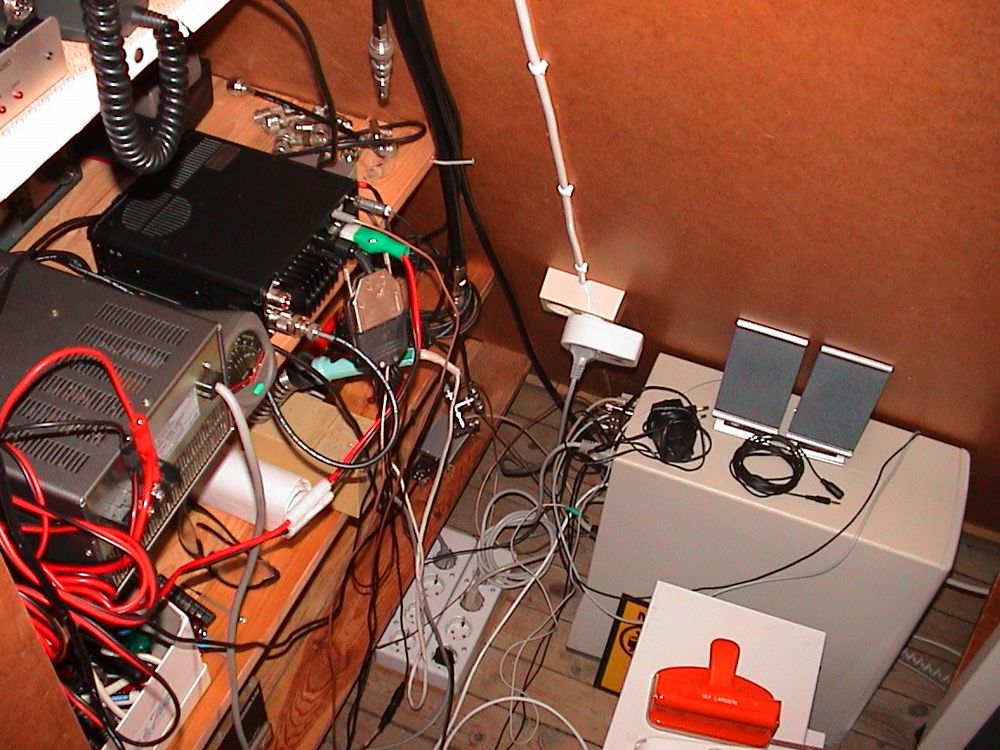Working radio at remote location!
It’s
a fine feeling to get home from work, settle down in that comfortable chair and
then check out the bands. I put out a CQ call with the keyer and get a reply
from a station in England. Sure it’s fine but a little strange since I have no
antenna or radio in my shack here in Solna (close to Stockholm) where I live. My antenna and radio
are in our summer cottage down on the island of Öland off the south east coast
of Sweden. Working a station in England isn’t especially unique – but it is
when you work it on 10 GHz.
How
is this done then? Let me try to
explain in this article! I will let others
explain how long range QSO’s can be made on microwave.

Ulf SM0LCB at home in Solna active as SM7LCB on Öland.
- Remote control of the IC-706
transceiver.
- Remote control of the
antenna rotor.
- Remote control of the
transverter, firstly for 1.3 GHz and higher bands.
- Sound transfer to and
from the transceiver.
- The Transfer of CW –
manipulator keyer or hand key signals to and from the transceiver.
All
these items excepting the last one were soon operational and worked locally in
my shack. I worked many Nordic Activity Contests on 1.3 Hz
with this setup. I tested the remote control of the rotor system during my many
visits to the island. In the spring of 2004 broadband was introduced on the
island and it was time to seriously launch remote control between Solna and
Öland. The summer of 2004 became intensive, installing the antennas, building
the radio hut by the antennas, hanging up the coax between the antenna hut and
the cottage and finally installing the computers broadband and the software.
When I left the island in August 2004 everything was fixed and working.
 My antenna installation on a nearby barn. |
 Antenna from top 1.3 GHz, 10 GHz and 24 GHz. |
I
was full of excitement when I got home to Solna and connected to the Internet,
powered up the radio on the island and began to work radio through the remote
system. Everything worked just as planned and I was a very happy radio amateur
when I first heard the noise from the radio on the island in the loudspeakers
at home. The real test came during the NAC contest on 1,3 GHz in august
and I am still active in this contest. I have also managed to work many fine
rain scatters and tropo-openings which are good fun, amongst others I have
worked F1ANH (SSB 1558 km) on 1,3 GHz as well as GM4LBV
(CW 1169 km) on
10GHz. More about this is on my home-page where log sheets, maps with squares
worked and recordings of the many QSO’s worked on microwaves can be found. The
answer to the question, ”Why work radio on microwaves”? can also be found there.
How
have I managed all this you might wonder? Well, you buy a radio and hack a bit
of code any radio ham worth his salt should be able to do it don’t you think?
Lets not joke about it, there has been an awful lot of hacking code and that
has taken a long time. Most of the methods used to work out the remote commands
are described on my home page, but here’s a short list of methods.
- Remote control of the IC-706.
My own software developed for Linux/Windows.
- Remote rotor control.
My own software in a PIC-processor (in the rotor box)
driven via ICOM bus from my own LOGGER program and Internet software for
Windows/Linux.
- Remote control of the transverter mainly for 1.3GHz and higher bands.
My own software in a PIC processor (in the
transverter) driven via ICOM bus via LOGGER program and my own Internet
software for Windows/Linux.
- Sound transfer to and from the transceiver.
I use freeware here, and today I use Team Speak and
IHU.
- Keyer and hand-key signal transfer to and from the transceiver.
My own software in a PIC processor at the keyer/hand
key as well as my own Windows/Linux to connect them to the transceiver make
this possible.
Is remote control of radio’s here to stay? The answer is Yes! At present I live in a QTH, Solna, which does not enable me to work microwave, so remote operation is a necessity for me to be able to work theses bands. Of course remote operation can be done in other ways but for me it was important to solve the problem by using my own equipment and software in the true radio amateur spirit. Already there are complete solutions on the markets and it won’t be long before they are available from the radio amateur stockists, then it will be easy for the ordinary “mains socket amateur” to use this method.
 Antenna hut at the antenna with rotor control, power supply and transverter for1.3GHz. |
 Installation in the cottage about 60 meter from the antennas with the radio, power supply, computer and Internet connection. |
However I am pleased with my own solution which allows me to operate my radio wherever I may be with the front panel on the desk and to call CQ with the manipulator-keyer or hand key to my transceiver on the island of Öland. For instance when I was present at the VHF-meeting in Norway I listened and worked my radio on the island of Öland in Sweden. It felt real good.
73's de ULF. SM0LCB/SM7LCB
Translated from Swedish by Derek/SM5RN.
Homepage http://sm0lcb.shacknet.nu
Mirror site http://sm7lcb.shacknet.nu
| SM7LCB |
End of this page
|
 |